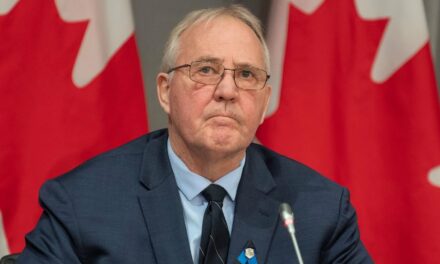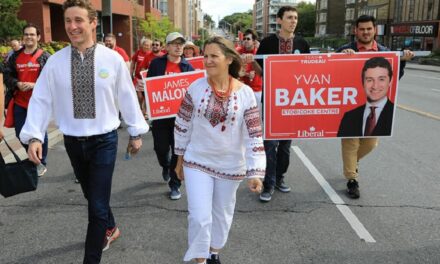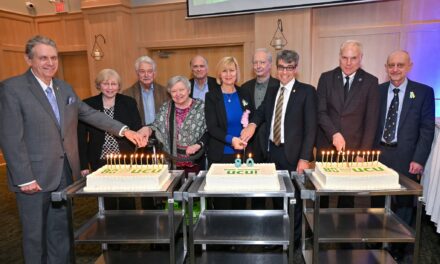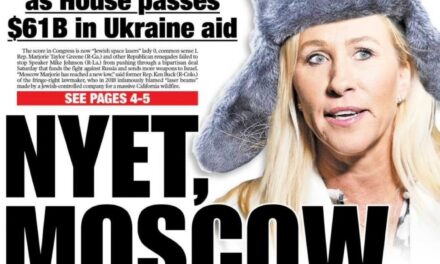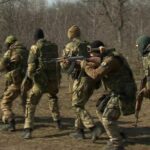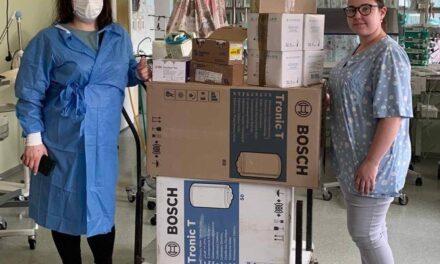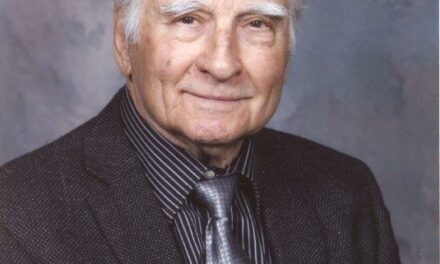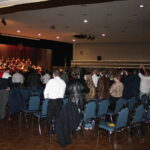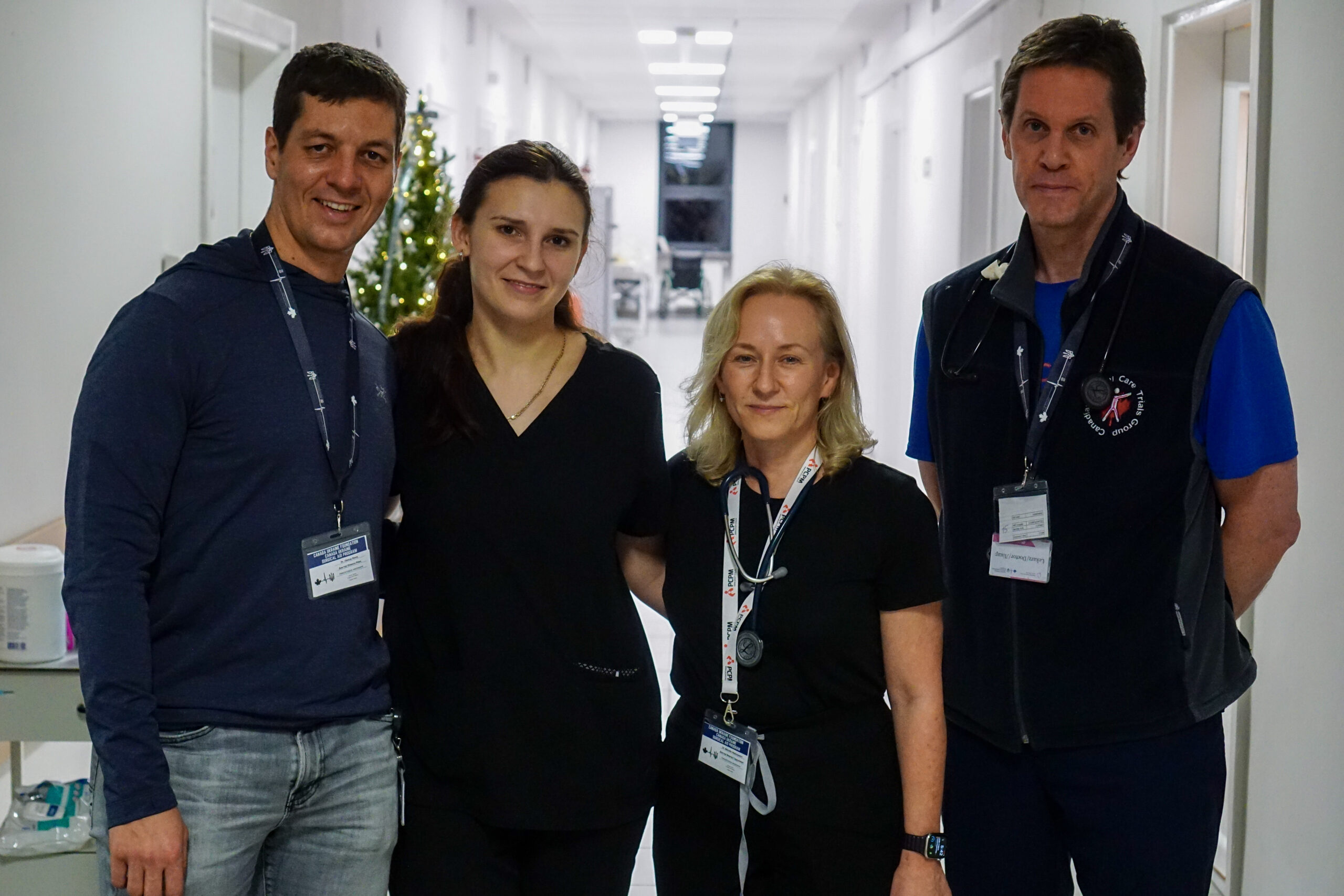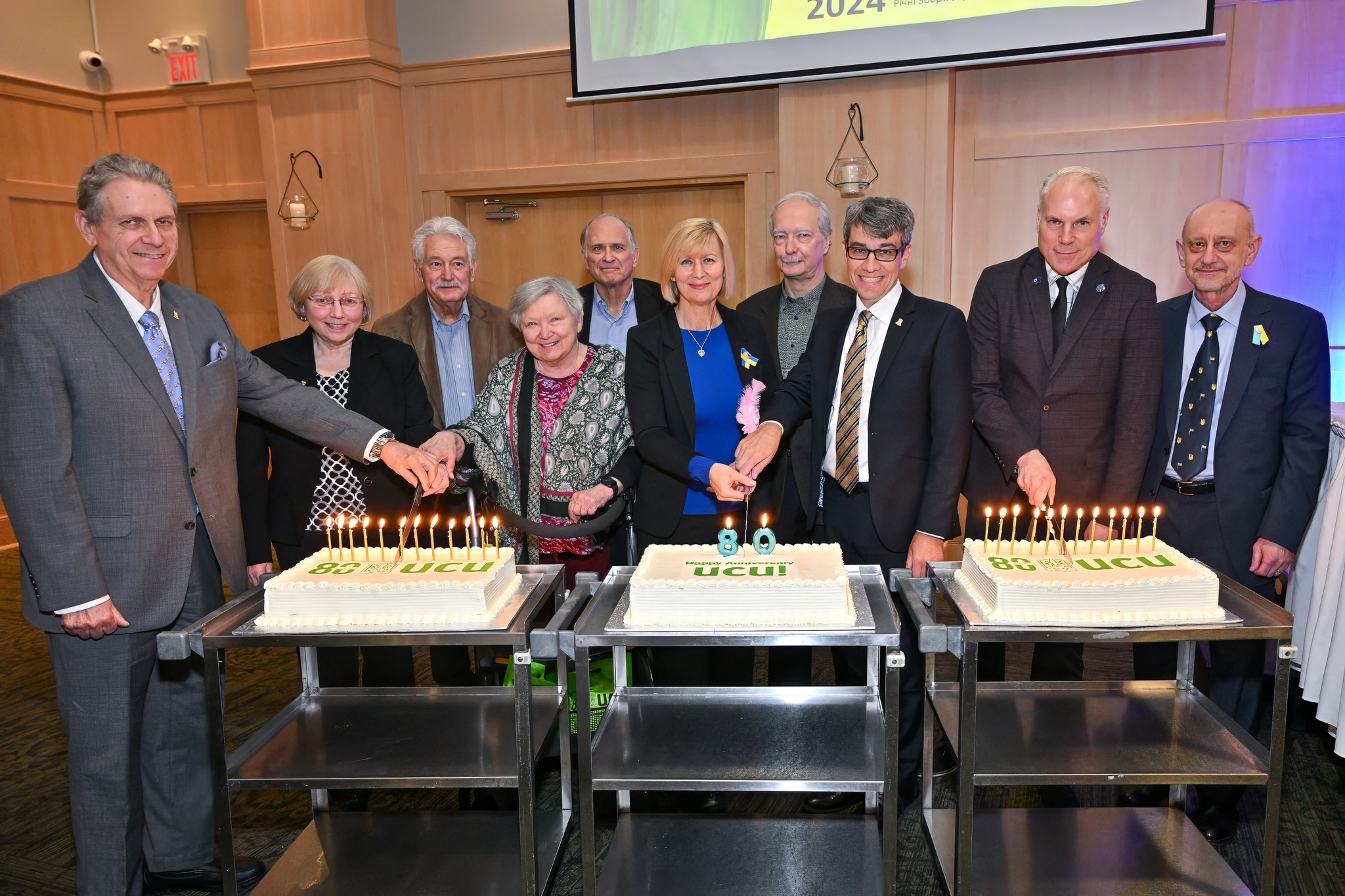Lidia M. Wasylyn for NP-UN.
“I have done a lot in my medical career, but nothing has meant more to me than doing this,” said Dr. Michelle Hladunewich, in reference to the Canada Ukraine Surgical Aid Program (CUSAP). This very important project of the Canada-Ukraine Foundation (CUF) is a humanitarian surgical aid initiative that provides life-changing medical care to patients affected by the war in Ukraine. Dr. Hladunewich is the Chief of Medicine at Sunnybrook Health Sciences Centre and Professor of Medicine in the Temerty Faculty of Medicine at the University of Toronto. She is a passionate and dedicated member of the surgical teams providing invaluable medical care to Ukraine’s war victims, both military and civilian. Dr. Hladunewich was introduced by Lubomyr Markevych, a native Edmontonian and 29-year resident of Ukraine who is on the Board of Directors of CUF.
Dr. Hladunewich delivered an outstanding presentation about the CUSAP in Edmonton, on February 12, 2024. This special evening hosted by the Ukrainian Catholic Women’s League Branch at St. Josaphat Cathedral, brought out a good number of people from the community. It was an opportunity to hear firsthand from one of the many highly trained, senior medical professionals who have been volunteering their expertise and time to provide complex surgical care to victims of the brutal war on Ukraine.
As readers of this newspaper may remember, the CUF surgical missions have been providing important surgical care for war victims in Ukraine since 2014, under the guidance and leadership of Dr. Oleh Antonyshyn. He is an internationally renowned plastic surgeon, specializing in both cosmetic and reconstructive facial plastic surgery. In addition, he is a Professor of Surgery in the Temerty Faculty of Medicine at the University of Toronto and has a very impressive record of publishing and remains active in the education of residents and practicing surgeons.
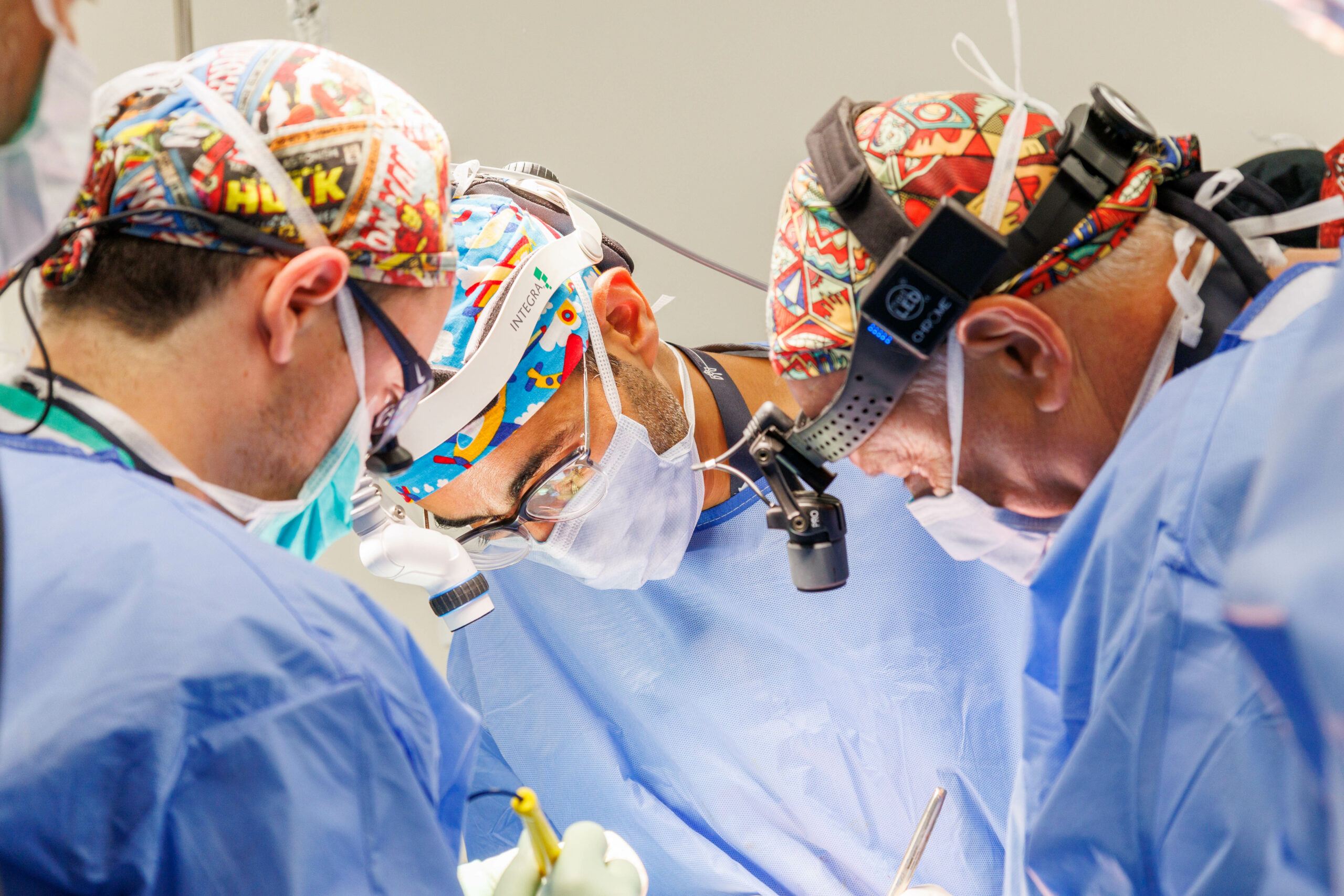
CUSAP mission: doctors operate
Start small and grow big.
The first surgical missions were small and held in Ukraine. The Canadian staff that included Dr. Antonyshyn, fellow surgeons, anesthetists, O-R nurses, and few other staff helped while the Ukrainian hospitals and staff provided the infrastructure and post-operative care. Medical supplies and equipment were purchased by the CUF and brought to Ukraine by the team. Each successive mission was larger than the previous one, with a total of seven missions in four major cities between 2014 and 2019. During this time, the missions “developed a remarkably effective model for mobilizing a self-sufficient comprehensive team to deliver sophisticated surgical care to war casualties” as noted on the CUSAP website.
“Love your neighbor as yourself.”
Dr. Hladunwich explained that because of the full-scale invasion of Ukraine in February 2022, the Canada Ukraine Surgical Aid Program was launched and had to quickly pivot to be able to provide medical care outside of Ukraine in neighbouring Poland. Surgical care in Ukraine became impossible under the conditions of the war. One must remember that medical facilities, clinics, and hospitals throughout Ukraine, along with all manner of other civilian infrastructure, including schools, have been deliberately targeted by the aggressor. These are indisputably war crimes Dr. Hladunewich noted that over four hundred hospitals have been destroyed or damaged, hundreds of ambulances and other health infrastructure have been destroyed or seriously damaged. Many health professionals have been killed and some have left the country. This makes providing care incredibly difficult. Conditions for all medical staff in Ukraine are extremely challenging and uncertain at best.
Holy scripture tells us to “Love your neighbor as yourself.” This could easily be the guiding principle that describes the support and cooperation provided by the Polish people and government. Since the full-scale invasion, the CUSAP missions have been operating in Poland, in the small town of Cžeładz, about a four-hour car ride from Lviv. Dr. Hladunewich described how the town’s hospital has become the anchor for the surgical team to provide the best possible medical care to the casualties of war. The hospital in Cžeładz provides operating rooms, post-op care rooms, a fifty-bed ward and access to laboratory testing, ex-rays, CT scans and other supportive care. The ward built to accommodate the CUSAP teams has been named the Canada Ward.
Moving the program to Poland very quickly in response to the new level of need, brought new, different challenges. These included regulatory approvals by the Polish government and the Ukrainian Ministry of Defence, licensing requirements for the medical professionals, insurance and financing, among others. There were challenges originating in Ukraine as well since the casualties of war and their Ukrainian support staff had to be given permission to leave Ukraine to enter Poland for treatment. As emphasized by Dr. Hladunewich, the primary goal of the CUSAP teams is to provide the absolutely best possible medical aid using state-of-the-art equipment and techniques. With the administrative challenges overcome, the CUSAP team continues to work around the clock to provide exceptional care in exceptional circumstances.
Who are the patients?
Dr. Hladunewich noted that the type and severity of the injuries experienced by the war victims is not anything she has ever seen in all the years of her practice in Canada. The injuries are the results of missile attacks, severe ballistic injuries, and crush injuries due to bombing of residential buildings, for example, and other unimaginable cranial injuries involving the head, neck and face and injuries to limbs. The war does not discriminate between victims, so patients treated by the team are both military and civilians. The military patients tend to be slightly younger while reservists tend to be slightly older. Civilian victims in comparison represent a wide age range and often suffer trauma from explosive devices, crush, and blast injuries. Currently, it is believed that approximately 10,000 civilians have been killed and another 17, 000 have been injured.
The number of military casualties is even more staggering. Approximately 70,000 military personnel have been killed and about 100,000 to 120,000 have been injured. It is anticipated that there are already approximately 20,000 amputees as a result of war injuries. Dr. Hladunewich stated the military injuries are more severe because of where and when they occur. There is no air evacuation of the injured, so they need to be transported by vehicle to the closest point where medical care is available and then further transported to a larger medical facility for treatment. One of the extremely serious outcomes of this kind of fragmented care and delays is the contamination of wounds, which is a huge issue in itself. Patients have been discovered with multiple bacterial infections some of which are antibiotic resistant, adding to the complexity of providing treatment to the victims.
The patients need to be treated quickly and thoroughly, as they must be repatriated to Ukraine as soon as possible. That means that patients are selected for procedures with a view to being successfully treated. As there is not always the opportunity for thorough follow up once the patient is returned to Ukraine, the CUSAP team ensures that the patients are provided with a three-month supply of all appropriate medications and any equipment they may require. If a patient requires multiple procedures, typically they are done in Poland all at the same time. This means a patient may undergo two or more types of surgeries during one operating session.
Patients treated by the CUSAP team are generally referred by health professionals in Ukraine. The patient’s medical information including x-rays and CT scans are forwarded to the team, who then assesses the information in advance to determine if the patient can be successfully treated and cared for after any surgeries. Dr. Hladunewich stated “we must choose surgeries carefully, so no one is left behind,” since post operative care needs to be completed before the patients are repatriated to Ukraine.
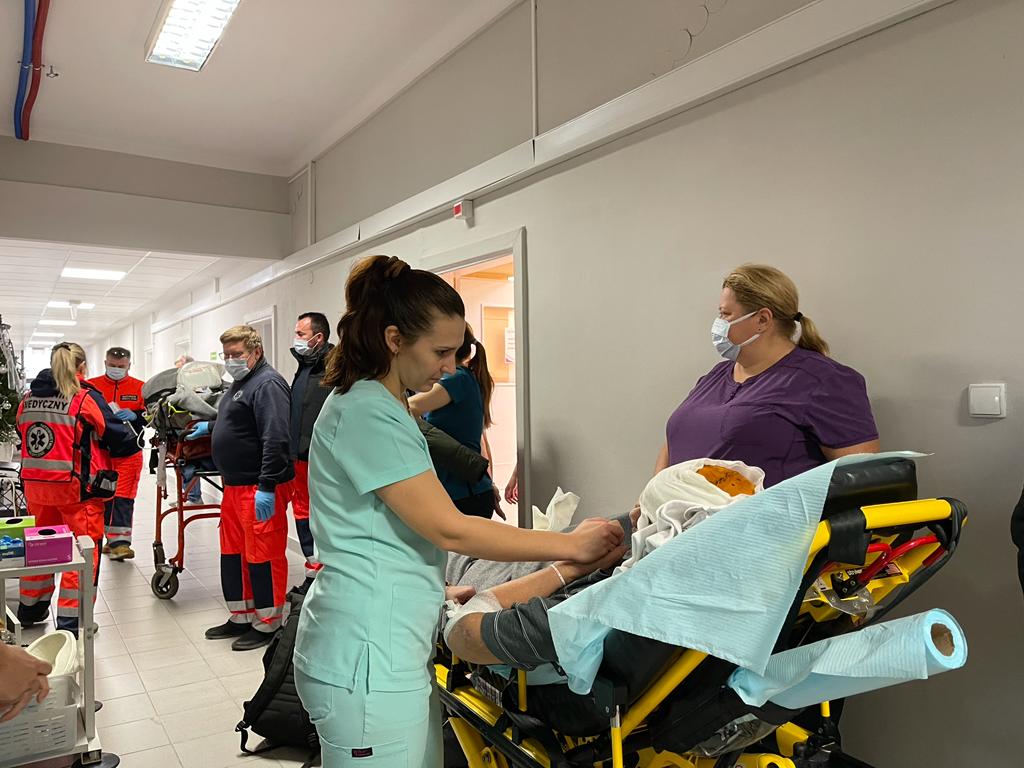
Admitting patients
Who is on the CUSAP medical team?
Dr. Hladunewich explained that participants in the missions come from across Canada representing some of the best trained and experienced medical professionals working in Canadian health care. The teams include physicians, surgeons, anesthetists, specialized nurses, pharmacists, occupational and physical therapists, IT specialists, drivers, a photographer, and administrative support staff. All are volunteers working together, for two weeks. They do whatever is needed whenever needed to support successful outcomes for the patients. As Dr. Hladunewich noted, “there are no egos on these teams” and participants need to be easy going, flexible and cooperative. Team effort is crucial for successful outcomes, and everyone works together. She noted some team members will arrive sooner to set up and others will stay a bit later to provide post operative care. The staff rotate in and out on shifts and are on call as needed.
There is no shortage of medical professionals interested in participating and contributing to the CUSAP missions. But they must be qualified and able to work as a team in challenging conditions. Those who do participate do so on their own time and are not paid for the work they do. They are truly volunteers. Doctors and other staff give up their vacation time, forego their conference time or amend their academic duties to be able to participate in the missions so their professional commitments in Canada do not suffer. CUSAP brings in all the medications, medical tools, and equipment they expect to need for the procedures they will be performing. Essentially, they bring with them a fully stocked hospital and pharmacy in a suitcase. Other supplies are shipped directly to Poland and held in a warehouse built near the hospital. Virtually all the supplies are donated or purchased with donor support, and everything is left in Poland for future use.
Only about 20% of the mission participants are of Ukrainian decent and the remainder have no affiliation to the Ukrainian Canadian community. As dedicated medical professionals they go on these missions to give back and provide the best treatment, using state-of-the-art, high-level equipment to make a difference in the lives of innocent war victims.
An educational dividend
The primary goal of these missions is to provide complex reconstructive surgical care to victims of russia’s invasion of Ukraine. However, there is the secondary benefit of leaving a legacy of professional education. The future of medical education in Ukraine currently is very precarious.
First, there was covid that impacted education and then the full-scale invasion that shut down many educational programs including medical schools. Doctors are treating casualties with less time to train new physicians. The CUSAP is trying to leave an education legacy by providing Ukrainian medical staff the opportunity to gain experience and share that learning with other doctors in Ukraine. Young medical students are offered the opportunity to assist with the missions as translators and even as temporarily licenced physicians assisting with surgical procedures. There are many hurdles to overcome to bring young physicians, particularly males, from Ukraine into Poland. However, the missions have been successful in getting the students into Poland and then have them return to Ukraine. This educational component supports the desire of young bright minds to pursue their medical dreams. Every procedure is live taped and is effectively a teaching session. New skills are being left behind and shared. This supports Ukrainian health care professionals with education in trauma reconstruction that is a legacy that will benefit many.
What are the costs and benefits?
All the participants are volunteers and are not paid for their services. As previously noted, virtually all the equipment and medications are donated or purchased with donor support. The benefits that accrue to the participants cannot be quantified. The ability to provide hope to victims who could not imagine living with severe deformities caused by war is a privilege. A former mission participant, nurse Nadia Warchola from Edmonton stated, “to be with these soldiers on three missions was incredible. I was blessed to be part of these missions.” Dr. Hladunewich repeatedly admired the boundless resilience of the Ukrainian people. It seems that what the volunteers get out of these missions is at least a much as the victims whose lives have been transformed for the better.
The essential costs of the various missions are funded through financial donations from the Ukrainian Canadian community and various corporate donors through the Canada- Ukraine Foundation. Details about donors are available on the CUSAP and CUF websites. As noted by Lubomyr Markevych in his closing remarks, the CUSAP missions are successful because of the participants “devotion and dedication to their patients. It is a credit to all people in our community” who support the important work of the CUSAP and CUF.
Share on Social Media







